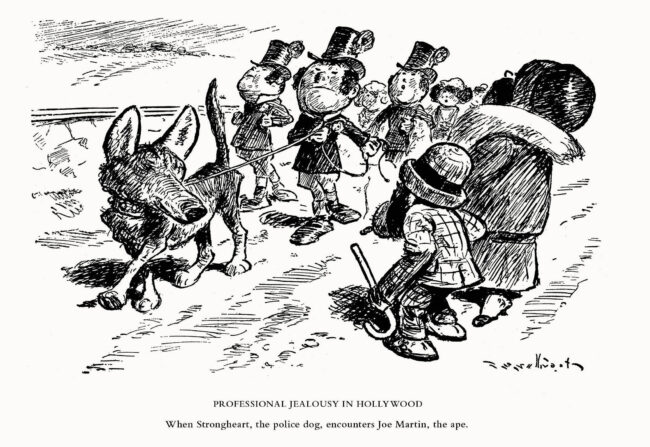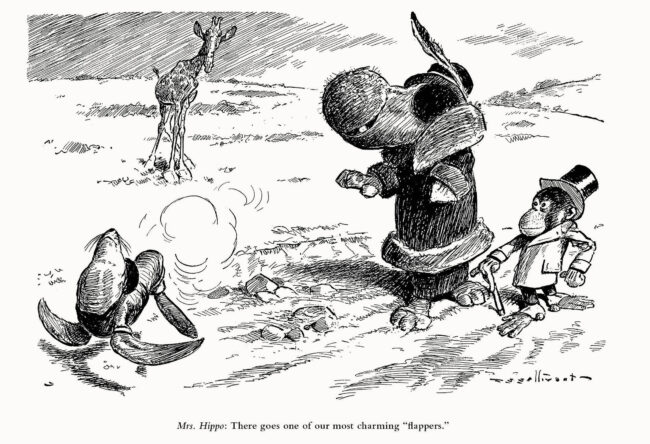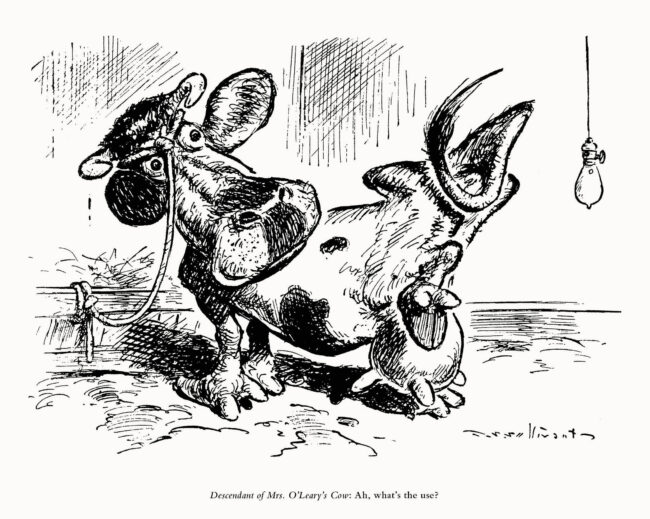This handsomely mounted and jam-packed book has heft and physical presence; it’s that rare book that is hard to comfortably sit with and read. Its subject is a cartoonist whom Pogo creator Walt Kelly and contemporary cartooning master Jim Woodring revere. The book is an ode to a virtuoso artist who some may find tough to approach in the 21st century. Aside from a smattering of ethnic caricatures that might raise red flags, there’s a detached, inscrutable quality to Sullivant’s work—the sense of his being a school of one, inimitable and impossible to categorize.
Sullivant took exaggeration, caricature and distortion into a twilight zone that sits near the works of Louis Wain and Fletcher Hanks. Sullivant avoided the extreme madness of Wain, and the grubby grotesquery of Hanks, but those same elements flavor his work. According to biographical information in the book’s text, Sullivant was a perfectionist to an obsessive-compulsive degree. Although a gifted draftsman, possessed of a mastery of contour, expression and form, he second-guessed himself with every pen or brush line he put to paper. It seems that he was never fully sure of, or satisfied with, his own work. Colleagues recall the constant sound of scratching from Sullivant’s drawing board, as he scraped away pen lines with a razor blade and re-drew much of his artwork ad infinitum.
The growing weirdness of Sullivant’s work hints at a curious and outrageous mindset from a Victorian era of suppression. His exaggerations of physical form, which amped up as he progressed, are baroque to a hairsbreadth edge of abstraction. Fish-eye lens distortion, wild physical action weighted down with compulsive cross-hatching/brushwork and grimacing, elastic facial expressions are constants in his most celebrated work. His figures seem impossible yet curiously alive. The artist’s capability at capturing attitudes of movement and emotion are fascinating. They’re often uproarious on their own, and when the wordy captions match the wit of the drawing, these 100+ year old cartoons can summon a guffaw from the viewer. Despite his frequency of the uncanny valley as an artist, Sullivant was a maestro of dry, under-stated humor.
A Cockeyed Menagerie approaches Sullivant’s work in chronological chapters, which begin with essays that segue into a curated selection of works from the time-period discussed. It is shocking to learn that a cartoonist of Sullivant’s status left behind so few clues about his motivation or personal life. Creators tended to be more reticent in Sullivant’s day, with the belief that their work should speak for itself. The streetwise cockiness of the early newspaper cartoonists, which extended their personality to the reader, was not Sullivant’s way. He drew his elaborate, punning pieces for weekly humor magazines such as Life and Judge, with some detours into political cartoons.
R.C. Harvey assembles the facts of Sullivant’s life in a well-wrought essay, in which he notes how Sullivant’s peers regarded him and reacted to his work, how his ideas and ability changed over time, and what makes his legacy still important in the 21st century. This is followed by an appreciation by Jim Woodring, who has written about Sullivant before, and a piece by Nancy Beiman that elaborates on how Sullivant’s work inspired animators to attempt to bring to motion the distortion, exaggeration and heft inherent in his cartooning. These three pieces do a great deal to gentle the reader into an appreciative frame of mind and begs their patience during Sullivant’s less-interesting early work.
As we witness Sullivant’s approach expand, develop and crystalize, his strides in caricature and expression never fail to impress. Strip away all the cross-hatching and these figures and their settings would retain their mass, contour and the breath of life inherit in the artist’s hand. It’s a pity that Sullivant limited himself to panel cartoons, with their dependence on sometimes-prolix captions. The book takes care to group cartoons by theme; seeing the artist’s variations on a common leitmotif helps smooth over the fact that this is a book of moments rather than attempts at more engrossing narratives.
It would be fascinating to see what Sullivant might have done with the comic strip format. His figures live and breathe for the minute or so we might spend poring over their visual details, reading the caption and chuckling. What might he have done with a narrative that filled pages rather than single panels? It seems unlikely that such a baroque visual style could be maintained; as the early newspaper cartoonists proved, less is more when a reader is asked to partake in a story. Details that enrich the finite canvas of a single-panel cartoon might pall (and exhaust the poor cartoonist!) at greater length.
Instead of a main course, the cartoons here are so many hors d’oeuvres—delicious bites of wit and visuals that can’t sustain our appetite indefinitely. This is a book that might serve you best taken in a few pages at a time. The essays, which also include writing by Rick Marschall, Barry Blitt, Steve Brodner, Peter de Séve and John Cuneo, are concise and enlightening, and help break the steady flow of cartoons. Ricardo Martínez ends the book with an examination of Sullivant’s original art. The cartoon “As Usual” is shown with a guide to the areas Sullivant revised with razor blade and pen, as it was printed in color in Puck and on its own as a piece of original artwork. This ties in with earlier essays in the book and makes better sense of Sullivant’s unusual work methods.
My favorite Sullivant work is his late period, where chunky figures, all wizened leers and gangling limbs, are rendered in bolder lines and seem to leap from the pages. Some of this work goes into places that are curious. The bottom cartoon on p. 309, for example, features a screaming tot whose features are an abstract wrench of pain and upset. On p. 323 is an image of a cow that is almost Cubist in its distortion and forceful linework. I look at that drawing and cannot fathom how Sullivant did it. Everything is poised to express the anger and frustration of the bovine. The emotion is tangible and sculptural yet so gonzo in its construction. I wish we knew more about the man who made this and the hundreds of other drawings that fill this massive book. What little we do know is tantalizing, but it is not enough.
A Cockeyed Menagerie is a book I will continue to absorb over time. It is a dense proposition, but there is much to savor here and as much to puzzle over. The patient reader will be enriched as they experience this incomparable cartoonist’s life and work. Justin Allan-Spencer and Sean David Williams deserve kudos for the book’s fine design, and the reproduction of Sullivant’s artwork is crisp and clear. Any artist would be honored to receive such lavish treatment.













